Saturn's misfortune: how Sega was forced to abandon console manufacturing
Topic posted the 2021-09-26 in the category Histoire et TechnologieTopic updated: 2023-08-26
While still in the middle of a fight against the PSX and the N64, the Sega Saturn was killed in a few months.
La version française de cette article est accessible ici.
Introduction: 1992-1994, designing the Saturn, and a long list of mistakes
At the beginning I didn't want to write a big introduction for this topic, but it clearly became difficult, even impossible (in fact, the introduction will probably be one of the bigger parts of this article). So I am sorry. It will be a big reminder for those who lived that era or a quick presentation for the young ones who didn't.
During the 80's a company named Sega became one of the two biggest video games company in the world, both on the hardware - console and arcade, the latter having almost disapeared today in the western world - and the software. Just behind big N (Nintendo). While Nintendo took the lead in Japan, Sega put all its energy to fight them, taking this leadership sometimes in North America and Europe. With the MasterSystem first, and the MegaDrive (Genesis in North America) then, Sega has become one of the most popular companies in the world, a popularity represented by Sonic The Edgehog, the Sega's alter ego to Mario the plumber of Nintendo. To achieve that, Sega developed strong partneships with EA, Disney and even worked hand in hand with the development studio of Sony. Unfortunately, this latter did not went farther mainly because of Sega's reticences.
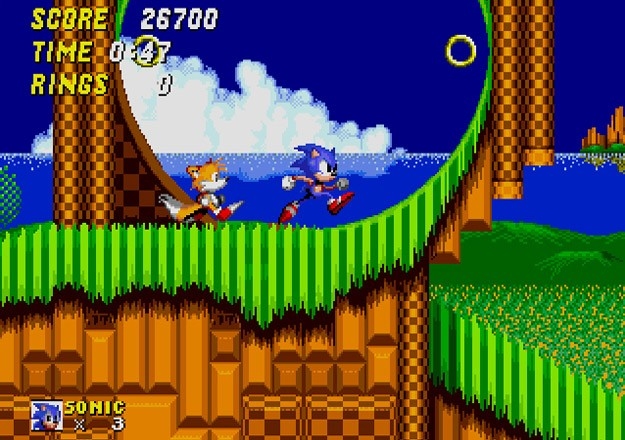
Sega managed to create a mascot and make it alsmost as famous as Mario
Many things were different between those companies. We can mention two of them : first while Nintendo depicted itself as a family-friendly company, Sega targeted teenagers, renegades, punks, and agressively attacked, through advertising, its main competitor. Then, while Nintendo issued hardware, stable and quite robust, of the era, and let it live its life, Sega tried many times to be ahead of its time and also was one of the first company to rewamp some of its devices to lower cost and/or extend the lifespan of the device, with a relative success. The best example has been in our hands : while Nintendo met a huge worldwide succes with a monochrom console named the Game Boy, Sega tried to rock the world with a colored one named the Game Gear. However, despite some great successes, a lot of worldwide hits, Sega stayed behind Nintendo for various reasons that would take too much time to explains, so let's go to the main topic.
While Sega of America (SOA) was trying to imagine how to extend the capacities of the Genesis (MegaDrive) and its lifespan (despite the failure of the SegaCD, a first extension for the Genesis), considering the huge success of this console in America and Europe, the headquarters in Tokyo - Sega of Japan (SOJ) - were already figuring the next generation of console, the 32 bits ones. In 1992 two projects were on the track: the Sega 32x, a new hardware extension for the Genesis, and the Saturn, a brand new system, which was already a little bit late. There were not an alternative project to each other, they were both to be realized. The first one was to be able to do basic 3D, untextured, and the second one to be a queen of the 2D but with a full 3D ready system, with the ability to texture the polygons. Sega was hoping to capitalize its huge experience and success in the 3D through its arcade systems to bring it to our homes then, but the Saturn was supposed to be kept inferior to the arcade machines: the CEO of SOJ wanted to keep these machines as the 3D showcase for the firm. Let's note that Sega also invented, kind of, the different levels of hardware like we see it today though consoles with pro or lite versions: the 32X was a lower budget device and the Saturn the big fully featured one.
As the Genesis was going well in America, the 32x project was "given" to SOA by SOJ in very bad circonstances - the relations between the two entities were already bad, while the latter would focus on the Saturn. The development of the Saturn was steady, going well despite some difficulties, and while Nintendo announced a CD extension for the SuperFamicom (Super Nintendo in Europe), Sega was not concerned at all. Things didn't changed when later Sony decided to go alone and to produce its own hardware system, named "Play-Station" back then. But in late 1992, something important happened. A company named Silicon Graphics who had become famous in the motion picture industry for its 3D realizations through great hardware and software contacted Sega to offer a deal to use their 3D chip into their new console. Sega engineers were showed all the capacities of the component, but while impressed by the incredible features and the power of the chip, were pesimistics about some not (yet) resolved issues. On top of that, according to some sources, SOJ wanted the exclusivity for the chip while Silicon wanted to distribute it under licence, and finally Sega declined the offer, prefering to continue to use the Hitachi chip they had selected during the Saturn design phase, even if this latter was greatly inferior to the Silicon Graphics one. What was the problem then ? Well Sega didn't see Nintendo coming. In september 1993 Big N indeed announced officially (work had already started earlier) a partnership with Silicon Graphics, and by this, implicitly declaring its entrance into the race to the next generation of consoles. It was a blow into Sega's face. The impact was quite important: the company, understanding that Big N took the opportunity they didn't and will have an hardware better than them, decided, almost in a hurry, to add a second 3D Hitatchi chip, allowing more calculus power to the Saturn. This small event will have a huge impact on the console life and on the Sega demise.
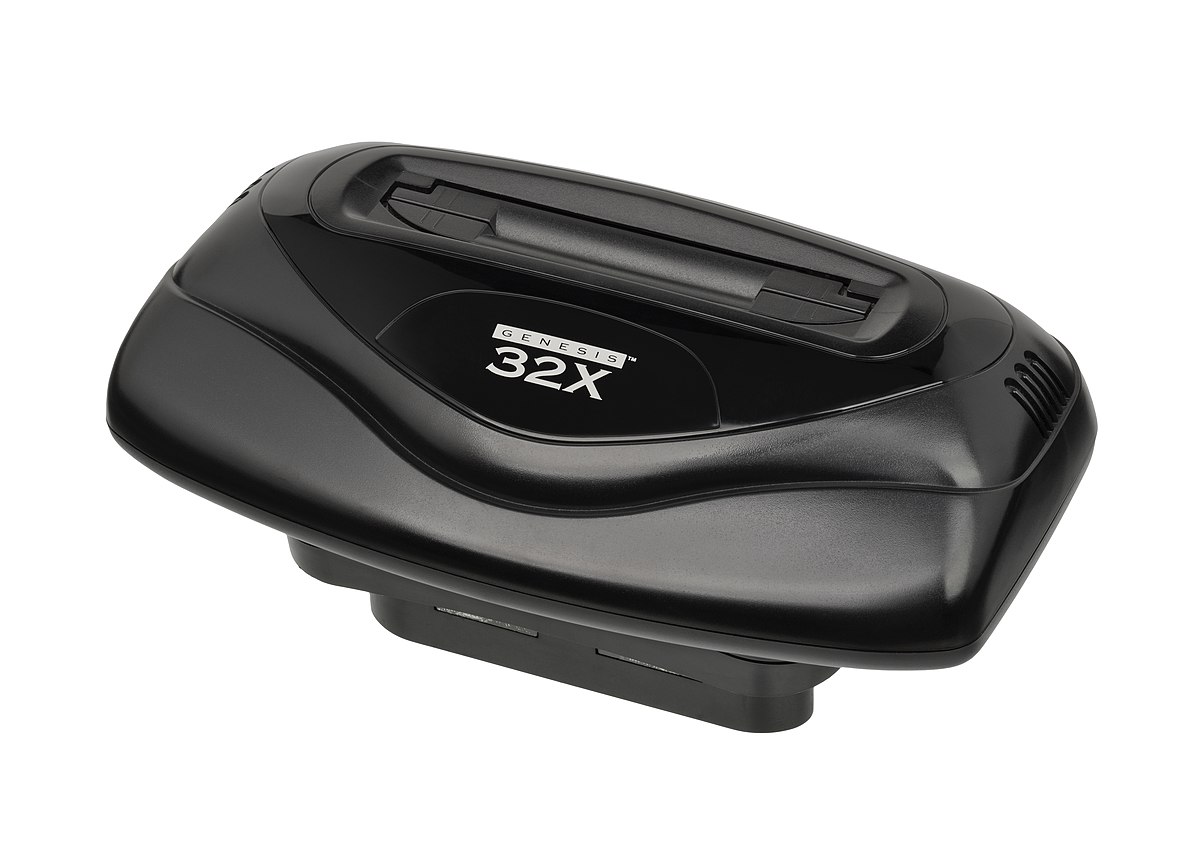
The 32x was supposed to be a low cost entry device in the 32 bits world. While SOA wanted to extend the lifespan of the Genesis in North America, their boss considered this "thing" as a bad idea as he considered more clever to create a new 32 bits console directly instead.
To make things worst, still in late 1993, Sony made a demonstration of the capacities of the future Playstation to a whole set of developers coming from various third-party editors (you can see the T-Rex Playstation demo on Youtube). It was a blow to these developers, in a good way, but a bad one to Sega who understood this day that the Saturn, even before its release, will have a very very serious rival. While considering Nintendo as the only rival, a rival a little behind on the hardware matter, Sega not only found out that Big N was already at the same level and that a new competitor was already on the front-line, with serious arguments... These warnings were however not enough and instead of completely rethinking the project, Sega decided this last-minute (often bad in whatever industry) change in the architecture of the Saturn and decided to continue.
Another point, which would become very important when the price war would occur: the Saturn was costly to develop, Sega relying on third-party manufacturers. Facing it, Sony was manufacuring its own components and was able to produce a cheaper console.
1994-1995: a failed launching
Now, let's do a jump ahead on time and just sum-up what happened. Fasten your seatbelt. Sega released a complex console without any SDK (software development kit) and almost no documentation, on the market. Then SOJ imposed an early, unexpected, and to selected retailers only (which had to sell the console without any margin, Sega selling it to them to the public price) release of the Saturn in late-1994 in America, 6 months after the release in Japan, triggering an angry reaction of some retailers and giving frustration to buyers. On top of that, the line-up of the console was ridiculous, and won't increase for months, and the console itself quite expensive. Just after that Sony did the opposite: releasing a console designed for 3D, with a relatively simpler architecture, with a SDK, with documentation (and samples), with a good line-up, and cheaper than the Saturn. Things were done at the beginning. Saturn would never recover. Sega too.
On top of that, the 32X was a fiasco discontinued after only one year, disturbing customers who did not understand why Sega released two 32 bits consoles.
Let's go back to the main issue, the main one, the architecture of the Saturn. Yes you can recover of marketing or launching issues, sometimes with difficulty, but the architecture of the console is here and you have to deal with it. The first 32 bits games on both Saturn and PSX were often uglies, but the learning curve - Sony did what it was needed to be done - was shallow on the PSX while very steep on the Saturn. Developers had to figure out how to master the hardware, and dealing with these two display processors were often a nightmare. Some of the studio decided to use only one, some others decided to use them with various techniques of their own like one to handle the background and the other the "active" 3D objects. Another things, both processors did not have the exact same features... Complex isn'it ? Another issue was transparancy, native on PSX but to be implemented in various ways by various developers on Saturn. Another thing: the Sega console could only draw rectangular polygones while the PSX could do other forms. Another issue was (would become) the means allowed to the Saturn projects: many games released on this console were ports from the PSX. And when the time of the port came, many studios did the minimum, producing something that was far from using all the capacities of the Sega console, feeding the rumor that the Saturn was greetly inferior to its rival. One note for the readers who are not in the software (or even in any tech area) industry: when a developer or any engineer is facing a new technology, he is also facing deadline to ship the software, hence reducing the flexibility to master the new technology, experience finally coming over and over the subsequents projects.
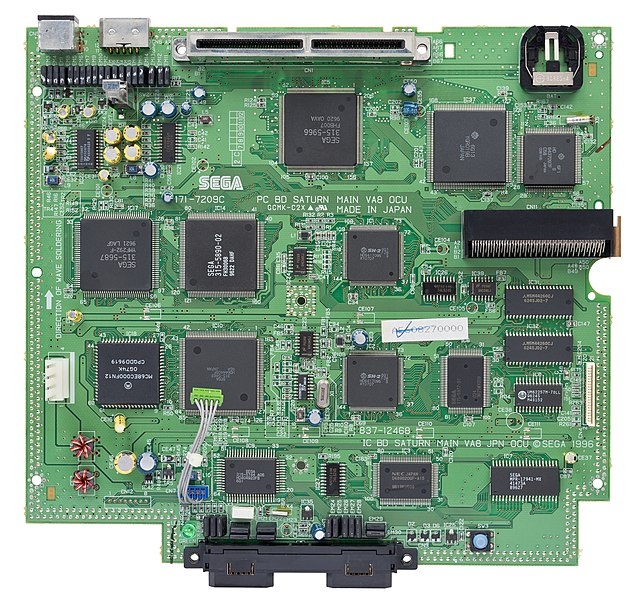
The Sega Saturn's motherboard. Brilliant design for some people, great failure for others.
I won't list all the mistakes done by Sega with the Saturn, there is plenty of litterature about it. Let's go on.
After one year, the situation is bad for the console. While the Playsation is shining all over the world, the Saturn is only meeting success in Japan, the opposite of what a happened with previous Sega's devices. SOJ, who has initially claimed that its hardware could dominate the market for the next five years is already considering the replacement of the Saturn (the Saturn 2 project at first, the Katana project then). During the two previous years : Sega has lost itself with a catalogue of 5 consoles and, financially speaking, losses of about 1 billion of yens.
1996: many good surprises and finally in place!
However, from late 1995, things were changing positively. First, financial results of Sega are still goods (they sold 2.000.000 of ... Genesis that year). Then, something has changed for the Saturn. The console is still the leader on its domestic market, and while far behind on other ones, third-party editors are producing more and more games. But the main demonstration comes from Sega itself: the adaptation of many games of the "Virtua" series, from the arcade to the Saturn. The example of Virtua Cop is a good one, showing that the machine could handle properly good 3D and that editors don't have to be worried about what is said about the Sega console. The company has also produced, finally, a documentation and some libraries to help developers. Things a changing, in a very good way.
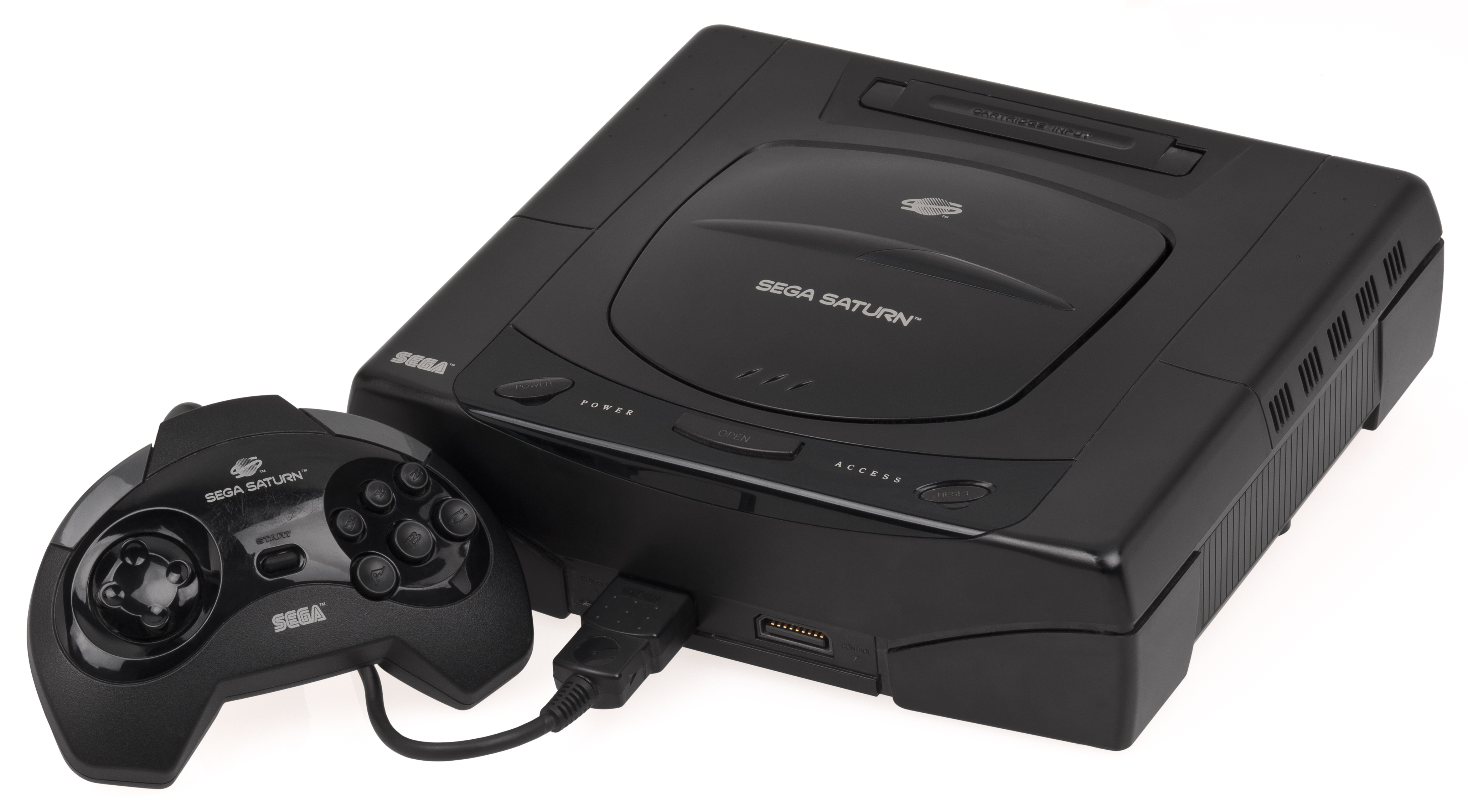
The first version of the Sega Saturn for the western markets. The second one had grey circle buttons instead.
Things continued in this direction during 1996: Sega finally managed to put the Saturn properly on the track. Despite the huge lack of a Sonic version and of system-seller games (games that make people to buy the console to play at this specific game) and that most of the reference games were from Sega itself, editors will progressively release various great games, like Tomb Raider or Pandemonium, Biohazard (Resident Evil in Europe)... Sega had then the means to compete with the PSX while the N64 entered the market. The company then needed to go to the next level. The best way was to create packages of games (bundles) sold with the console, and to continue to successfully port great arcade games (Virtua Cop 2, Sega Rally), redesign a little bit the console (to reduce production costs, a huge financial hole for Sega) and produce new devices.
Sega will release that year: a new 3D analogic controller, along the beautiful and widely praised game Nights into dream, a modem to play online (the Sega Netlink), and a memory extension of 1MB to increase the power of the console. The Saturn also saw that year the first sequels of games which had positive critics, like Bug Too or Panzer Dragoon Swei. This year Sega took some actions and started to make plans to assure a more promising future to the console : they considered to need "6 to 8" games with network capabilities from 1998. The analyse of the market and of its own difficulties also made Sega to face the reality: SDK or not, third-parties needed help. In this year 1996, internal notes show that Sega was already aware that others studios were lacking of skills and that ports to come, like Destruction Derby or Wipeout would be inferior to their PSX counterpart. SOA proposed to SOJ to 1) stop financing ports and instead invest in studios so they would create great quality games that the PSX could not rival with 2) to be sure that the best PSX games would also be developed (not ported as is) to the Saturn. This wish remainded a wish.
But that's not everything! On a hardware perspective, the year to come seems to be quite attractive: Sega just anounced that the awesome Virtua Fighter 3, released with a lot of success on arcade, was going to be ported on the Saturn in 1997, to equal quality with the arcade version, with the help of a new 3D extension of the console greatly improving the 3D abilities of the system, opening a new field of perspectives for the system! A few weeks later, Core Studio executives were in Tokyo and saw by themselves the 3D extension and a running demo of VF3, with two playable characters. In the meantime, Sega wished to limit the develpment of 2D games and push for full polygonal 3D instead, an irony considering that the console was initially developped for 2D.
On top of that, a 4MB RAM extension is going to be released soon.
Sega ends the year with a positive communication claiming the leadership of the Saturn on the Japanese market and a huge progression in America and Europe. Are bad days behind?
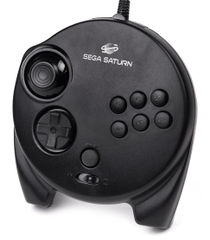
The Sega Saturn analogic controller had a a good design, inspiring the future Dreamcast's one.
However, we must also notice three bad news for Sega. The first one being the leaving of Tom Kalinske, the head of SOA, who had to endure all the bad inspirations of SOJ. We will come to that later. The second one is of financial matter: Sega is losing a lot of money with the Saturn (some sources mention 83 EUR of 2022 per console), and the fact that they had to follow Sony on the war price made things worst. The third one is that despite the positive figures in terms of sales, the gap with the PSX is not filled: the Playstation is going to take the lead in Japan, probably soon, and its advance in other markets seems uncatchable. It is very unlikely that despite the great 1996 year the Saturn would be able to challenge the Playstation for the leadership of these markets, the bad start in 1994-95 will be a permanent heavy ball attached to its feet.
1997: the beginning of the agony
After 2 years of struggle with Sony, Sega seems to have finally be able to push its full forces in the fight and having recovered from the long list of errors during the early days of the Saturn. The console is now well installed in this competitive market and third-party editors are developing more and more games, including system-seller ones. Increasing sales rates could let observers to be optimistics, and fan enthusiastics, about the year to come, promising an intensive battle between Sony, Sega and Nintendo. However, those happy days are not going to last for the Sega fans...
In 1996, the release of hits on the Sega Saturn, both developed for Saturn and PSX, showed to the world that the two manufacturers were almost fighting with equal means and that the bad start from the Saturn was clearly from the past, and the hardware extensions announced were allowing to dream for new hits even of better quality than that of the Sony console. But over the months, it become clear that this view was very optimistic and a sequence of catastrophic events occured. One after the others, third-party editors started to leave or deconsidered the console. The main reason ? No, that's not the exclusivity deal signed (for some of them) with Sony, it will come later. There are actually two reasons: the first one is that the console performances (technical and financial) are dispointing most of the developers, and the second one is that Sega itself seems to be shattered by an internal struggle and that this fight is clearly visible to everyone.
1- Third-party editors are leaving
As we saw earlier, during the first days of the console some editors became sceptical about it because of the poor documentation and SDK. Some of them decided to go on but other did not. We can, for instance, mention the french studio Adeline Software who briefly considered to port its hit Little Big Adventure on the Sega machine but did not went further.
Let's come back in 1996. In that great year for the system the Sega's fans saw some hits to be both released (or announced to be released) on PSX and Saturn, let's list some of them: Tomb Raider, Biohazard (Resident Evil in Europe, late 1997), Destruction Derby, Alone in the Dark 2, Pandemonium (june 1997, see later in this article), Die Hard Trilogy (in january 1997 to be accurate), Doom, Quake.
Now, various magazines are announcing some sequels, and the Saturn is going to have all of them, for this year, on the next one. But over the months, bad news are succeeding and all of them are cancelled. What the hell happened ? Let's review some of them.
- The Tomb Raider sequel was officially considered for the Saturn. The issue is that the first episode was a bad port of the PC one (a lot of games released on the two consoles were first developed on PSX and then ported on the Saturn, but this one was first developed for PC). It was even a short (one month) exclusivity for the Saturn version over the PSX release, reducing QA time and voices localization were not done unlike the PC and PSX versions. If visually the versions were quite identical, at the exception of few details, the framerate was catastrophic, standing 25fps with difficulties, sometimes impeding progression in the game. Because of the lack of time, Eidos wanted to use the same engine for TR2 than TR with some improvements instead of developing a new one. On the Saturn, it would have been difficult, and the studio was, officially, expecting the release of the 3D extension cartridge mentioned above. But this extension was quickly cancelled, and TRII on Saturn was too. It is the official reason, and a good one. For some observers though, the excuse of the insufficiant hardware of the Saturn is not acceptable, after all, many studios had to take some times to master the complex architecture of the console and TRII could have been a good port this time. For them, the reason is mostly that in spring 1997 Sony was already discussing the exclusive deal with Core to have the TR franchise for the 32 bits only on the PSX.
- Resident Evil II (Biohazard II) was already in preparation for the PSX and the port for the Saturn already announced, as it was done for the first one (by a Sega subsidiary named Nex Entertainment). Sources (Sega Saturn Magazine UK, april 1998) said that it was to be released in late 98 or early 99, an improved version of the PSX one, using the above-mentioned 4MB extension. But it seems that Capcom quickly considered that the Saturn CPU was not enough powerful to allow a good port, and the project was canceled a few weeks after being started leaving this great game to the PSX and... a not so good version for the Dreamcast. Later, in october of the same year, in the same magazine (issue #36), Noritaka Funamizu, the general producer of the Capcom development division, stated "It would have been impossible to do a Saturn Biohazard 2. We don't really need any more RAM, the real problem is that the CPU is too slow and it doesn't have the power to handle graphics calculations. Maybe Sega's own development team could push the CPU closer to its top perfomance, but we couldn't." This version is challenged by some observers: for them this excuse does not stand and Capcom was probably already looking at the Dreamcast (hence the low quality RE2 release on this console which is supposed to be based on the incomplete version developed for the Saturn). But finally, the studio considered to develop a new Biohazard game exclusive for the Dreamcast, this one will be a future hit too: Code Veronica.
- The port of Destruction Derby 2 was already in progress in early 1997. But in the middle of the year Acclaim decided to leave the Saturn market and cancelled the project (along Adidas Power Soccer also in development for the Sega's console). According to some sources, the port was 95% completed. It leads to a double frustration: firstly because the second episode was even better than the first, et secondly because we can wonder if the developers, after the experience of the first episode, could have made something even better on the Saturn.
- The sequel of Alone in the Dark (titled The new nightmare) was released on the Dreamcast in 2001. Even if the Saturn would have been still on the market (the game was also released on PSX and PS2), it is very likely that no port would have been attempted on the Sega's 32 bits. Indeed Alone in the Dark 2, while graphically equal to its PSX counterpart, was plagued by poor perfomances, camera and playability issues. The game was a hit on PSX but disregarded on Saturn.
- Pandemonium 2 was released on PSX, but I found no mention of any port on Saturn. The first episode was almost equal with the PSX one, both in terms of graphics and playability, but still a little bit under. It is interesting to note that the game was released 6 months after the PSX version. In Europe one of the reason is that the company in charge to publish the game for Crystal Dynamics was against the fact to publish games for the Saturn. Sega then bought these rights to publish in Europe, certainly wanting to avoid the third market in the world beeing restricted from the first great platform game on the Saturn.
- Need for speed II, the sequel of the hit - which was as good on Saturn as on the PSX, was never released on the Sega's console. I found no mention that the development was even started.
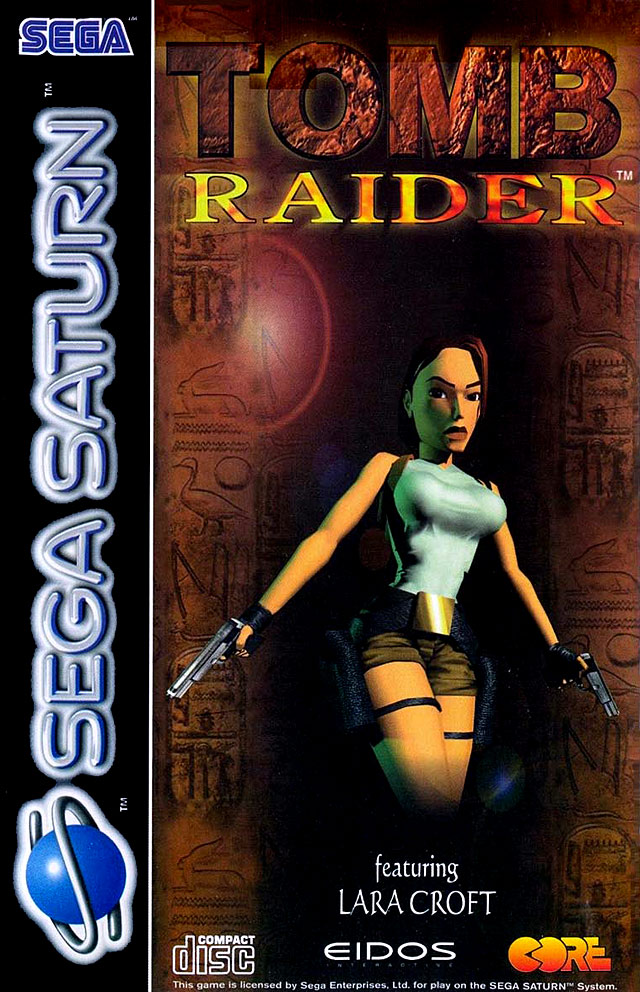
The Sega Saturn never got the sequel of Tomb Raider. If you are curious, you can watch real-time comparison between the Saturn and PSX releases of the first episode.
Side note : there was no sequel to Die Hard Trilogy obviously. But the case is still worth mentionning: some sources mentions that the port on the Saturn needed the help of some Sega's consultants.
The absence of sequels to those hits was a major blast as they were true system-sellers. But the Saturn was also crippled by more or less major events on the field:
- Sonic X-Treme, displayed at the 1996's E3, was officially cancelled in january 1997. While some voices are still claiming that the release of what (the leaks show it) would have been a great game could have saved the Saturn, I humbly think that they are quite exagerating. However, it was another hit the in the Saturn's face, in a time where the PSX had its Crash Bandicoot and the Nintendo 64 its Super Mario 64.
- The 3D extension cartridge announced by Sega, despite beeing in later stages of development, was cancelled without any reason (at least I didn't read anything serious about it). The hope to see great 3D games, of superior quality in comparison to the PSX ones, was lost with this cancellation. However, Sega released the announced memory extensions cards (1MB, we saw it earlier, and 4MB) that allowed developers to create more demanding games, some of them with graphics for which the qualitity auto-adjusted to the memory available (however, like on the N64, some games required these extensions to work). These accessories never reached the western market, hence had no effect of the console fate.
- Despite the cancellation of the 3D extension, Sega stated that the port of Virtua Fighter 3 would still be done this year. It was finally cancelled despite the success of the previous episodes, the success of the arcade version, and hence the great expectations of Sega's fans. The game was finally released on Dreamcast.
- Some notable games both released on PSX and Saturn in 1997 still showed the difficulty to exploit the capacity of the Saturn in comparison to the PSX (even when the studio had the time and the money to try to do its best). If Croc was a good port, it was still a little bit behind the PSX version. One of the few exceptions is Exhumed (PoweSlave in the US and Canada), which is, according to some critics, was better on Saturn. But this case is very interesting, because according to the lead developer of the game huge efforts were done on it and the team developed it owns tools to work on the Sega's console, and then because these tweaks were so advanced that when the studio started to work on the PSX version later, they hade to re-design some part of the engine, leading to a lot of modifications and making the two versions quite differents, which makes comparison difficult. The engine they developed for the Saturn was used again when the company became in charge of doing the port of Duke Nukem 3D and Quake, both from the PC version, the engine for the later couldn't be ported easily on the Saturn.
- Duke Nukem 3D, despite the acclaimed critics which considered it as equal to the PC version and the ability to use the Internet connection, had a few impact. One of the reason beeing the the Sega NetLink was not available in Europe, leaving european players without multiplayer mode.
- Sony was more aggressive in terms of deals, looking for exclusivity with editors. For instance the great Medievil (1998) which development started in 1995 was proposed both to Sega and Sony, the latter signing the exclusivity deal with the studio. V-Rally (though as a F1 game at the beginning) was planned for the Saturn first but finally developed only for the PSX.
Among the other hits (on other platforms) that were cancelled on the Saturn, we can also mention EA Sports FIFA World Cup 98, Croc 2, Fighting Force, Diablo, GTA, Heart Of Darkness... However, for this list, it is not always clear if they were cancelled because of the Saturn's situation or for other reasons. For Heart of Darkness for instance, initially annonced for juily 1997 and then for september of the same year, the game was supposed to be a Saturn exclusivity (on console, but later to be released on PC), but the development took so much time that when the game would have been ready for release, the Saturn market was no longer viable. The viability angle also applied to Gran Theft Auto and to Nuclear Strike, the sequel of the good Soviet Strike (one of the rare games that was better on Saturn than on Playstation, in this case because it was released later allowing to fix bugs). This cascade of cancellation deprived the console of hits and hardware-sellers games like Virtua Cop 3 (in 1996, the game was expected for late 1998) even if some of them, initially started on Saturn, would be released on Dreamcast, like Resident Evil 2 (Biohazard), Virtua Fighter 3 or Shenmue (initially expected for may 1998 on Saturn).
2- Sega first resignation
We already have talked a lot of what happened on the field. Let's now go to see what was going with the white collars. Over the years the tensions between Sega of America (SOA) and the mother vessel Sega of Japan (SOJ) have been well known to the public back then, SOJ leaving less and less freedom to its american subsidiary. Difference of opinions, of vision of the future of the company were the main part of the issues. All of this has been highlighted, or illustrated, by the difference of the reception to Sega's products in different markets. While the Genesis and before it the MasterSystem were total successes in North America and Europe, they lagged behind Nintendo in Japan. With the Saturn, it was the total opposite, the Saturn beeing a true success only at home. This limited success will have an impact overseas: Sega tries to cut down budgets, including translations, and some hits like Lunar or Grandia won't be ported on the western markets. Today these games are described as must haves if you own a japanese version of the console.
On top of that, the Saturn, from conception to release, was an idea under total control of SOJ while for previous devices SOJ was only in charge of the conception, leaving marketing and release work to the local subsidiaries. The fact that the MegaDrive was a total success in North America and that SOJ was pushing the Saturn in a hurry while there were still room for the MegaDrive didn't help. Among the Saturn ennemies was a man named Tom Kalinske we mentioned in the introduction. From the very beginning he considered the marketing position of the console and the pricing not well suited to the market, and on top of that, he knew that the architecture of the device was far too complex, but SOJ didn't considered that at all and Kalinske had to follow the orders given by SOJ, including those which led to the failure of the launching and the difficult beginings of the console in the USA and in Europe. Despite this he and his team tried everything to give the Saturn a chance but the Playstation was a too big piece. Kalinske finally left the company in mid-1996. Following his departure SOA was restructured and the project, on the software level, was now between the hands of a man named Bernie Stolar.

Croc "The Legend of the Gobbos" was one of the last game to be both released on PSX and Saturn. While a little bit under its counterpart, the Saturn version is good (but the fact that you were forced to start the console before inserting the disc otherwise the head of Croc would be missing. This was discovered too late and the editor had to insert a note in each game manual). Same thing for Riven, the sequel to Myst, which got rankings as good as the PSX version. Another example: World League Soccer 98, as beautiful and fluid than the PSX version.
Stolar was a former VP of Sony Computer Entertainment America, and as soon as he joined Sega it seems that he tried to continue the job done by Kalinske : to fight not only for the Saturn survival but also to continue the progression in terms of market share, but... he also claimed that Sega "need to kill the Saturn" and to start the development of the next generation of console for the company (something that was already in progress as mentionned earlier in this article). He was helped to this decision a few months later, despite some official announcements highligting the (true) increasing sales of the console, by the figures that became indeed quite alarming : the gap between the PSX and the Saturn was becoming bigger and bigger. On top of that, Sega had to follow the many price decreases decided by its competitor, leading to a precarious financial situation for the manufacturer. 9 months after his arrival in SOA, Stolar was promoted to head of operations and he had the mission to help to prepare the future of the company, in other words, the difficult mission to save it. And he did not waste time to make it know.
Indeed in june 1997, he sent a socking message, indirectly. In the middle of an interview at the E3 in Atlanta, two simple sentences made him the nemesis of most of the Sega's fans: "We did a mistake with the Saturn" and "The Saturn is not our future", announcing a new device for the end of 1998. Those two phrases, repeated out of context didn't help to put confidence in third-party developers and potential buyers who were still hesitating between the Saturn and the PSX. In the meantime, the PSX received all the sequels to the hits mentionned earlier in this article and also exclusive system-sellers like Final Fantasy VII...
There is however something to remind, to be fair : many times I read on social networks that the cascade of cancellation on the Saturn were a consequence of Bernie Stolar's speech. That's wrong and unfair. If you look at the timeline, the cancellations were well spread over 1997 and early 98, so before and after Stolar's announcement. On top of that, let's recall that clouds initially came from Japan in 1992. Back then, while the strong efforts of SOA let Sega to get 50% of the market share in the USA, SOJ was stuck at 15% in Japan. The japaneses seemed to have badly accepted the success of the americans and decided to take over on the whole process, from the console design to the business strategy, letting almost no decision making capacity to SOA. We know the result. Years later, the boss of SOJ was relegated to another position, but it was too late.
Conclusion
In a few months the vision of the future of the Sega Saturn has completely changed. From hope and excitement fans were led to a dark future, leaving them three choices: 1) wait and see, 2) wait for the next console, the Dreamcast (then named the Katana Project) which was going to be announced soon, 3) or to sell their Saturn to buy a competing machine. The rest of the year confirmed them that the Saturn was to be abandonned, the quantity of releases dropping and system-sellers games disapperaring, even some hits released in Japan were not adapted to the western market (and even in this case, the port was still not as good that the PSX version, for instance Castlevania: Symphony of the night, which despite extra features for the Saturn version, was clearly done without trying to benefit of the superior 2D capacity of the Sega console). In the begin of the year 1998, releases of the Saturn had become more and more rare while the PSX was still on the edge of the popularity (and hits like Metal Gear Solid, Parasite Eve and Silent Hill were still to come). Among the last few games released on the western market, FIFA 98 and NHL 98, months behind the PSX, N64 and PC versions, were once again small dispointments, lacking behind their PSX equivalent (regarding Fifa 98, this critic has already been done one year earlier for Fifa 97).
Finally the official discontinuation of the Saturn, for which rumor could be heard in spring 1998 when the console was receiving its last notable games (Riven, Panzer Dragoon Saga*), was announced on the 5th of november 1998, but games production continued until 1999, almost only in Japan though. It is interesting to wonder what would have been the future of Sega if the Saturn had not known such a fate. Would the Dreamcast have been released so early ? Would Sega have maintained both the Saturn and the Dreamcast as Sony did with the PSX (until 2002) and the PS2? In any case, unlike what is sometimes considered like a certainty, the Saturn was not the fatal blow to Sega as a console manufacturer. It was the initial one, and the company never fully recovered. The failure of the console, despite the aborted career, costed a huge amount of money to the manufacturer. The firm had one chance to recover and to get back to the peak of its popularity like 5 years earlier. This chance was named "Dreamcast".
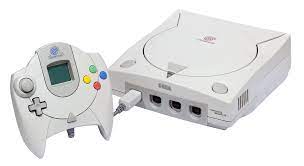
The Dreamcast had the difficult mission to put Sega back on the track.
You know what followed: it was not enough, and this time Sega was not faulty. The Sega Dreamcast had a good design and was may be a little bit ahead of its time. Despite encouraging figures in the beginning, the 128 bits console did not reach the expectation and SOJ had to let it go in 2001, "it was a matter of life or death" for the company. This time the culprits were players, who after the poor launching of the Saturn and its premature (for them) drop of support by Sega let them distrustful, at best, or even angry for some of them (let's remind that the failure of the Saturn was the third of a list over the previous years, after the MegaCD and 32X ones). I remember in fall 1999, while walking in a mall in southern France, the newly released Dreamcast was being promoted in a stand. A lot of people were around the various screens, and I clearly remember one guy saying "Well. That's great indeed... But I will wait for the Playstation 2". I think we all heard this sentence in those days, and it clearly sum-up what of lot of us thought (I still have a Dreamcast though, but I bought it around 2004 when it was already discontinued, and it is clearly a good system). On top of that Sony, was already marketing its future PS2, which would include a DVD player...
But let's not be so assertive, third-party editors played their role here. EA for instance did not want to develop games for the Dreamcast. I have read many reasons, none of them being certain, but in any case the absence of some hits like the FIFA series, Madden... didn't help.
May be it is pure nostalgy, but I miss Sega and wonder what they could do today in hardware (if they still had a department working on).
*Panzer Dragoon Saga has been depicted by some critics to be one of the most beautfiul games on the Saturn, equals to what could be done on the PSX, supporting people who were thinking that the Saturn was not inferior to its 32 bits rival. One critic said that if this game had been released on PSX, it would have been a major success.
Cet article vous a plu? Découvrez d'autres articles :
- Introducing GMG: an application to manage your videogame collection publié le 25-06-2022
- JAW: a headless blog CMS publié le 26-05-2022
- What has changed in our relationship with video games over the last 25 years. And what has not. publié le 16-05-2022
- Gaming archeology: retro-engineering on Beasts and bumpkins publié le 25-04-2022
- Gaming archeology: retro-engineering on Ultimate Soccer Manager 98 publié le 17-04-2022
- PHP 8.1 : un petit exemple simple avec Fiber et CURL publié le 05-03-2022
- Les malheurs de la Sega Saturn : comment Sega a du cesser d'être un fabricant de console publié le 24-11-2021
- Saturn's misfortune: how Sega was forced to abandon console manufacturing publié le 26-09-2021
- Extract-Transform-Load : faire de l'ETL avec PHP publié le 15-06-2020
- Les helpers sont-ils anti-pattern? publié le 17-07-2018